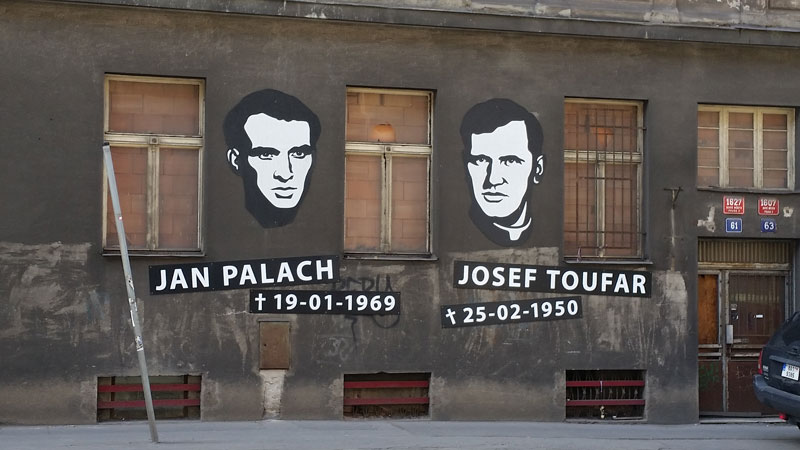Story of a Photograph
I never know where I’ll be drawn next when I’m writing about Prague. This was supposed to be a religious persecution post, but it took a few turns and left me with a big surprise at the end. It started with a picture I took years ago of an empty building at Legerova 61-63 very close to the National Museum and thousands of people will drive past it every day. It had been stored away under “political protest”. This month I was sorting photos and the journey began.

On the left is Jan Palach. This is a story that I know well and I’ve written about before on both the Jan Palach Icon post and the Suicide Mother post. The whole reason for taking that picture was that it showed Jan Palach. On the right is Josef Toufar. If you are Czech then you learn about this guy early on in your life and if you are religious again, he’ll pop up. But I’m neither. For me it started with sorting photos and normally this would have stayed in the political protest folder but then I noticed the Josef Toufar date, 1950.
2020 is the 70th Anniversary of that terrible year. I know 1950 more for political persecution. The communists had taken control of the country and there were a series of “show trials” which resulted in the death of many who opposed the new regime. At this point I started steering away from the original topic of religious persecution and focused more on the individual man.
The Political Background
In 1950 it’s about 18 months after the 1948 Communist Coup. The communists were still cementing their powerbase and identifying threats to themselves. They were deeply suspicious of the church and it’s ability to organise.
The Miracle
Josef Toufar was a priest and in 1948 he had arrived at the village of Cihost. On December 11th 1949 during a service some 19 members of the congregation saw a metal crucifix move several times during the sermon. Josef Toufar did not see this as the cross was behind him but word spread of the miracle. People started to visit the church as a pilgrimage. A local photographer took a picture of the cross, made copies and gave them to Josef Toufar to give away to church visitors (later the photographer was sentenced to 13 years in prison for doing that). Word also spread to communist ears.
The communists took the opportunity to try and prove that the miracle was faked and ultimately to discredit the Catholic Church. This proof was basically a forced confession beaten out of Toufar before he died. There are other aspects that leave a bad taste in the mouth. After the beatings he was taken back to the church to “re-enact the miracle”. The Security service Stb had installed a series of wires to make the cross move and tried to get Toufar to operate it. They filmed the whole thing with Toufar close to death, unable to stand properly being held up by Stb guys (it was so bad that another priest had to replace Josef Toufar). When shown the propaganda film, Czechs laughed at the attempts by the security services to prove the lie. He died in Prague on February 25th 1950 and was buried under a false name in a mass grave in the city. His parents weren’t told of his death until 1954.
The Ahhhh! Moment
So as I read about the topic I learned that Josef Toufar not only had died in Prague, he died in the building in the picture because in 1950 and throughout the communist period Legerova 61-63 was a medical facility (the Boruvka Sanitorium) and it was where Josef Toufar died of his injuries and hence why his picture was on the wall. But hang on, why is Jan Palach’s picture on the same building?
The Surprise
On my walking tours if we talk about Jan Palach then I explain that he self-immolated on 16th January 1969 and although taken to hospital, died of his burns 3 days later. What I previously did not know was that the Boruvka Sanitorium was the closest medical facility (only 200 metres from where he self-immolated) and had by chance become a specialist burns hospital so that was also where Jan Palach died on January 19th 1969.
Something Related or a Few Minutes Away
Memorial – House of the Suicide Mother
History/Communism – 1948 Communist Coup
